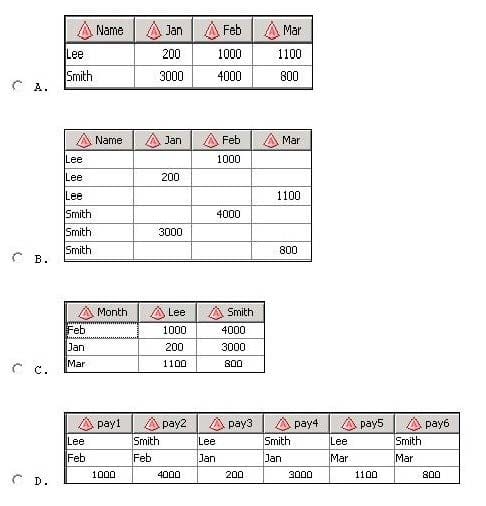Exam Details
Exam Code
:A00-260Exam Name
:SAS Data Integration DevelopmentCertification
:SAS Institute CertificationsVendor
:SAS InstituteTotal Questions
:70 Q&AsLast Updated
:Apr 14, 2025
SAS Institute SAS Institute Certifications A00-260 Questions & Answers
-
Question 51:
In SAS Data Integration Studio, which statement is FALSE regarding status handling?
A. When a job is executed in SAS Data Integration Studio, a return code for each transformation in the job is captured in a macro variable. The return code for the job is set to the least successful transformation in the job. SAS Data Integration Studio enables you to associate a return code condition, such as Successful, with an action, such as Send Email.
B. If status handling has been defined for a transformation or the job, a macro definition (and a call to it) will be added to the generated code to check for the specified condition(s).
C. Only one Condition/Action pair can be defined for a single transformation or for a job.
D. The available Condition/Action pairs for transformations and jobs will vary - that is, different Condition/Action pairs may exist for the SQL Join transformation versus the Table Loader transformation.
-
Question 52:
In order to use the SAS Data Integration Studio's Apply Lookup Standardization transformation, Data Quality options must be setup. Select the valid Scheme Repository Types. (Choose two.)
A. A comma delimited flat file that contains the field names in the first row.
B. Power scheme that is generated by Data Flux.
C. A SAS table scheme that is generated by SAS.
D. A third party RDBMS table that has been generated by the SAS system.
-
Question 53:
Which of the following is NOT a feature of SAS Data Integration Studio's Data Validation transformation?
A. The Data Validation transformation can generate match codes to provide de-duplication capabilities.
B. The Data Validation transformation can perform missing-value detection and invalid- value validation in a single pass of the data.
C. The Data Validation transformation provides de-duplication capabilities.
D. The Data Validation transformation provides error-condition handling.
-
Question 54:
You want to create a job that checks conditions for your data before that data is loaded into a data warehouse. The job should be able to detect error conditions such as missing data or duplicate data and take appropriate actions like registering error conditions in log, etc. Which SAS Data Integration Studio transformation should you use?
A. Data Transfer
B. Data Validation
C. Data Quality
D. Data Extract
-
Question 55:
Given the table below as a source table for the Transpose transformation in SAS Data Integration Studio:

In the Options tab in the Properties window for the Transpose transformation, if the columns are assigned as follows: Select columns to transpose (VAR statement): Payment Select a column for Output column names (ID statement): Month Select columns whose values define groups of records to transpose (BY statement): Name Which of the following tables is a possible resulting target table?

A. Exhibit A
B. Exhibit B
C. Exhibit C
D. Exhibit D
-
Question 56:
Within SAS Data Integration Studio, which type of expression can be created using the Expression Builder window in the Where tab of SAS Extract transformation? 1) a SAS expression 2) an SQL expression 3) an XML expression 4) a constant
A. 1 and 2 only
B. 1 and 3 only
C. 1, 2 and 4 only
D. 1, 2, 3, and 4
-
Question 57:
Consider the job flow diagram in the display. Assume the inner job has a parameter defined specifying a table name. Which statement is FALSE?

A. The Inner Job can be successfully executed by itself, but only if the defined parameter has been assigned a valid default value.
B. The Inner Job cannot be successfully executed by itself unless it is disassociated from the loop job.
C. The Control Table column is mapped to the parameter defined for the Inner Job using the Loop transformation properties window.
D. If the server that executes the job has multiple CPUs, parallel processing can be enabled in the Loop transformation properties window.
-
Question 58:
When writing postcode in the Precode and Postcode tab of the Transpose transformation in SAS Data Integration Studio, which symbol allows you to reference the transformation output table regardless of the actual physical name for that target table?
A. andsyslast
B. syslast
C. andtarget
D. %target
-
Question 59:
Consider the job flow diagram in the display. Which of these objects has parameters defined for it?

A. Control table
B. Loop transformation
C. Inner Job
D. Loop End
-
Question 60:
You want to create a table containing all customers from Italy. Assume that global customer order information is available in a single table. Identify the SAS Data Integration Studio transformation that will help you perform the task easily.
A. Append
B. Extract
C. Lookup
D. Mining Results
Related Exams:
A00-201
SAS Base ProgrammingA00-202
SAS Advanced ProgrammingA00-203
SAS Warehouse Development Specialist ConceptsA00-204
SAS Warehouse Architect ConceptsA00-206
SAS Warehouse TechnologyA00-211
SAS Base Programming for SAS 9A00-212
SAS Advanced Programming Exam for SAS 9A00-215
SAS 9.4 Programming FundamentalsA00-231
SAS 9.4 Base Programming - Performance-BasedA00-240
SAS Statistical Business Analysis Using SAS 9: Regression and Modeling
Tips on How to Prepare for the Exams
Nowadays, the certification exams become more and more important and required by more and more enterprises when applying for a job. But how to prepare for the exam effectively? How to prepare for the exam in a short time with less efforts? How to get a ideal result and how to find the most reliable resources? Here on Vcedump.com, you will find all the answers. Vcedump.com provide not only SAS Institute exam questions, answers and explanations but also complete assistance on your exam preparation and certification application. If you are confused on your A00-260 exam preparations and SAS Institute certification application, do not hesitate to visit our Vcedump.com to find your solutions here.